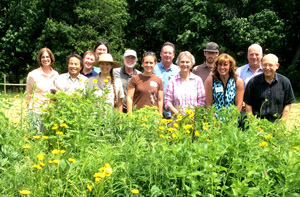IPM and Pollinators: Coordinated Action
 |
|
Northern New England Pollinator Habitat Working Group. Source: C. Neal, UNH Cooperative Extension |
Government sponsors are coordinating the actions of researchers, educators, beekeepers, and growers in the field in ways that could help reverse pollinator decline. For the winter of 2013–14, 23 percent of American managed honey bee colonies died, a figure notably lower than the eight-year average loss of almost 30 percent. Beekeepers used to lose only 10 percent of colonies.
The Northeastern IPM Center recently convened a panel asking how IPM can help stakeholders protect pollinators. Scientists and growers are applying IPM’s strategy of evidence-based, systematic thinking to the pollinator puzzle. The session streamed live in the fall of 2014; a recording is available on the web (What is the appropriate role for IPM on the issue of pollinators?)
Multiple causes at work
Some conclusions of the panel: Many factors could be causing harm to bees. Monoculture crop efficiency is good for increased yield, but reduces weeds and the diversity of forage plants that could enrich the diets of bees. It will be important to plant more diverse landscapes, reduce dependence on prophylactic seed treatment, and increase the use of IPM. For example, growers can spray in the evening and avoid treatment of fields when plants are in bloom. Consumers may need to get used to cosmetically imperfect produce.
More than neonicotinoids
Pyrethroids and fungicides are part of the picture, not only neonicotinoids. Neonicotinoids may be safer for water, since they are not water soluble, but they do get into plants and into nectar.* Some neonicotinoids could be safer for agricultural workers, since they are applied to the ground rather than sprayed in the air where they can drift. Researchers are asking how long neonicotinoids persist in the environment.
IPM supporters need to take a broad role in shaping the solution. One option would be to combine multiple IPM techniques under one label, like a dolphin-safe tuna label for IPM.
Ahead of the curve
The Northeastern IPM Center, through the National Institute of Food and Agriculture’s Regional IPM Grants, sponsored pollinator research and outreach as early as 2003, well in advance of widely distributed news reports about bee die-off in 2006. Between 2003 and 2008, the Center sponsored $350,000 in projects on pollinators. Between 2008 and 2014, it distributed $1.2 million for 23 projects.
Cathy Neal and Amy Papineau of the University of New Hampshire Cooperative Extension are coordinating a newly formed multistate Northern New England Pollinator Habitat Working Group that will identify emerging issues in conservation, maintenance, and enhancement of pollinator habitat across northern New England. The project is funded by the Northeastern IPM Center’s Partnership Grant program.
Partners in action
Regional partners are also taking action to increase our knowledge and outreach about pollinators. For example, the Southern IPM Center recently established a pollinator protection working group. The Western IPM Center funded a project in New Mexico that tested more than 100 species of mostly native plants for their ability to attract pollinators and other beneficial insects. The North Central IPM Center is an active supporter of pollinator health initiatives, and is the lead in collaborating with USDA and EPA on the current pollinator health activities. The Center funded one project that found that beekeepers should be wary of feeding bees high fructose corn syrup or sucrose, as these sugar substitutes are not nutritionally equivalent to honey. Honey contains compounds which could help bees metabolize and detoxify proteins that could be suspect in pollinator decline.
According to the Northeastern IPM Center’s panel, multiple factors appear to be causing pollinator decline. But one IPM strategy—applying science—is helping us piece together the pollinator puzzle.
*Neonics Correction
The article “IPM and Pollinators” in the April 2015 issue of IPM Insights incorrectly stated that neonicotinoid pesticides are not soluble in water. In fact, the solubility of imidacloprid in water is 610 milligrams per liter at 20 degrees Celsius. See http://npic.orst.edu/factsheets/imidacloprid.pdf and Hladik, M.L., D.W. Kolpin and K.M. Kuivila. 2014. Widespread occurrence of neonicotinoids in streams in a high corn and soybean producing region, USA. Environ. Pollution 193:189–196. Our thanks to readers who spotted this error.
— by CHRIS GONZALES
The Northeastern IPM Center promotes integrated pest management for reducing risks to human health and the environment. If republishing our news, please acknowledge the source (“From Northeast IPM Insights”) along with a link to our website.
